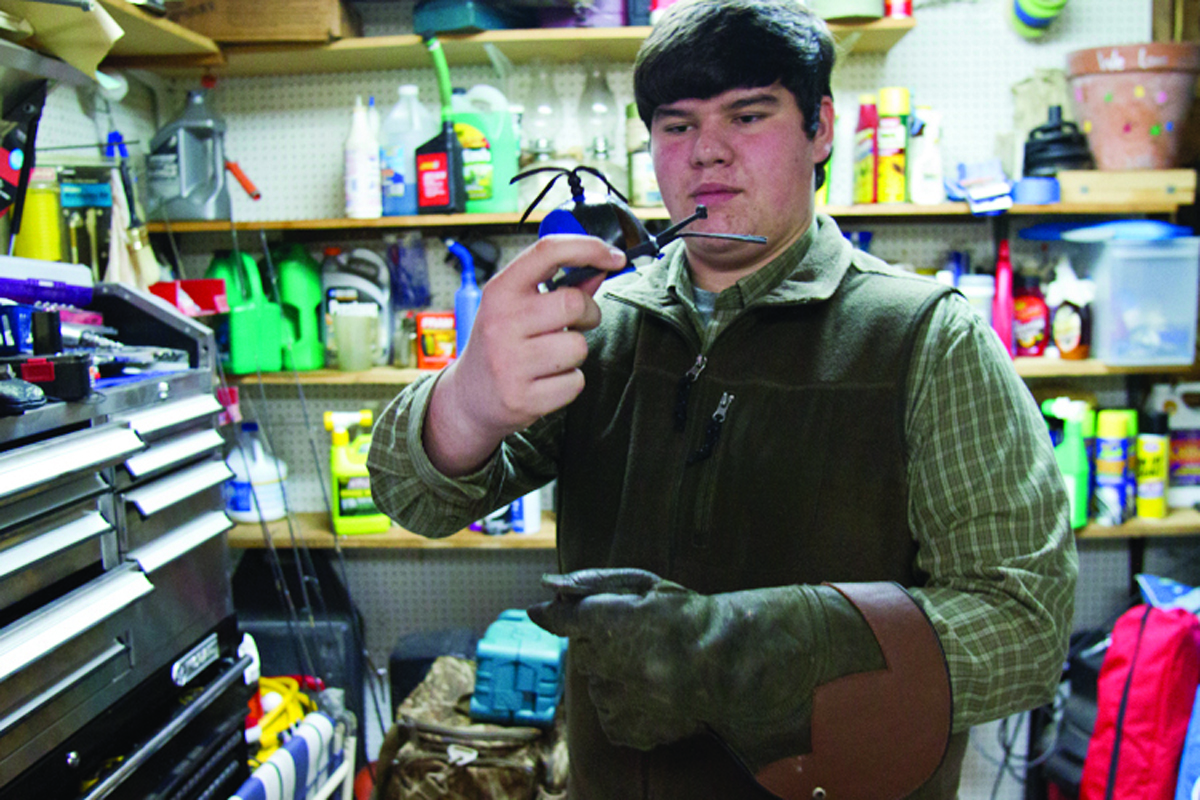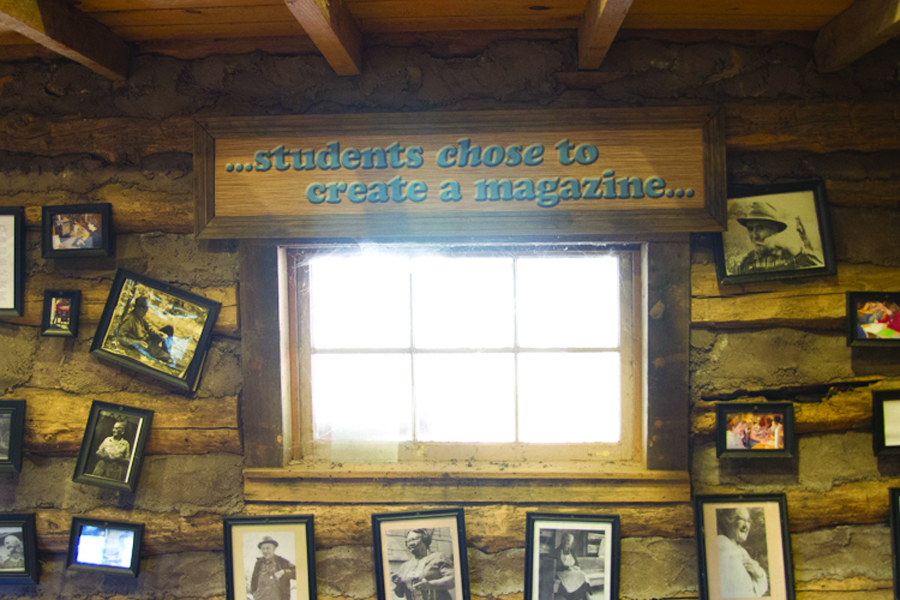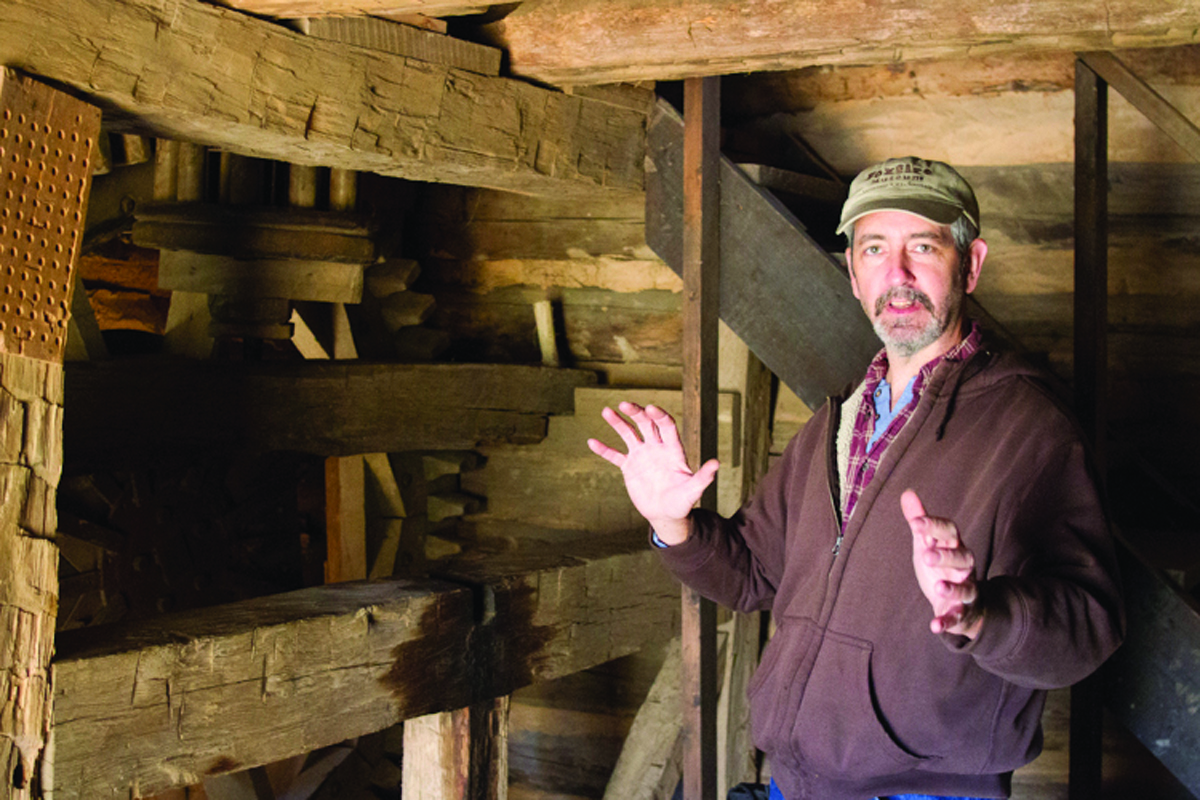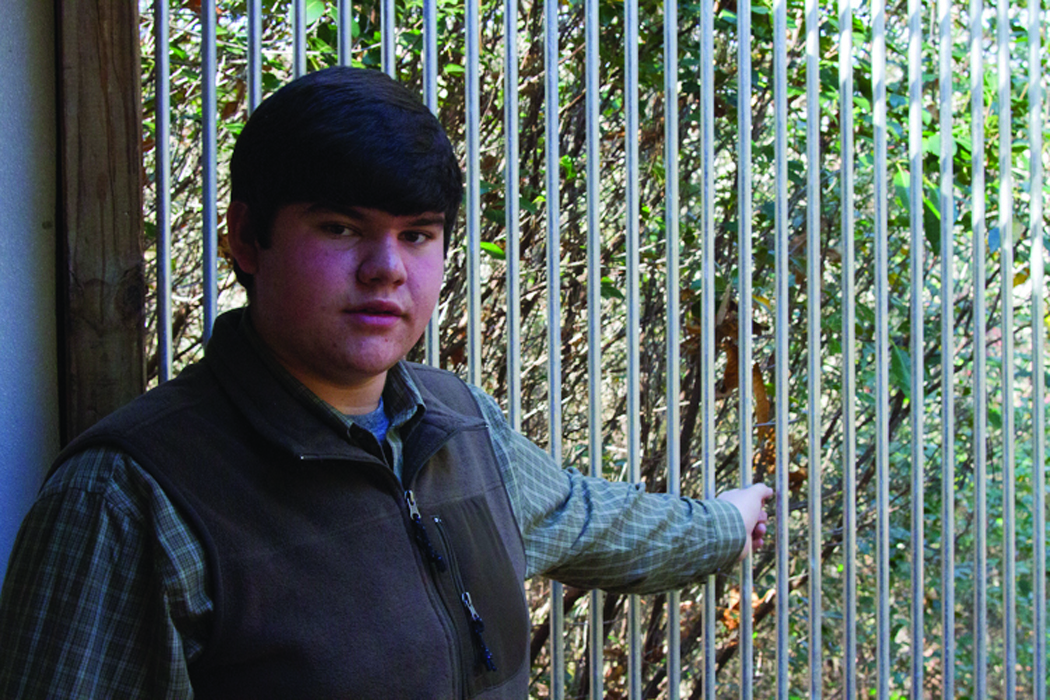 It’s first period, in late September, and students in the Foxfire Magazine class at Rabun County High School, in northeast Georgia, are doing what many journalists consider the least desirable part of their job: transcribing interviews. It’s time-consuming and tedious, but also necessary. Not just to get the facts right, of course, but to hear the telling tones and rhythms of voices — in some cases, voices not long for this world. Preserving these voices is part of Foxfire’s original mission, which is still playing out more than four decades after its birth here in the once-isolated mountain community where Deliverance was infamously filmed.
It’s first period, in late September, and students in the Foxfire Magazine class at Rabun County High School, in northeast Georgia, are doing what many journalists consider the least desirable part of their job: transcribing interviews. It’s time-consuming and tedious, but also necessary. Not just to get the facts right, of course, but to hear the telling tones and rhythms of voices — in some cases, voices not long for this world. Preserving these voices is part of Foxfire’s original mission, which is still playing out more than four decades after its birth here in the once-isolated mountain community where Deliverance was infamously filmed.
A fungus found in the Southern Appalachians that produces a dim glow — and a potent metaphor for ural education — Foxfire has come to mean plenty of other things. First it was an experiential kind of English class in Rabun County, brought to life in 1966 by an overwhelmed young teacher named Eliot Wigginton; then a book series that resulted from the cultural journalism magazines his students made; a museum memorializing the work; a method of instruction derived from it; and, “most importantly,” writes Ann Moore, executive director of the Foxfire Fund, “Foxfire is the living connection between the high school students in the magazine program and their heritage, built through interaction with their elders.”
Foxfire is also a reminder of a terrible thing that happened to some students while the good thing — the learning — was also happening. Sometimes good and its opposite can coexist, even in a single person or place. Even in a teacher. But we must not overlook the good that persists anymore than we should forget the bad. It’s all part of history—all of it important to remember and learn from.
At Rabun County High School today, Foxfire magazine is an elective that meets during two periods, four times per week. Students enroll for an entire year and produce a biannual magazine sent to 1,000 subscribers around the world, for $12.95 an issue. Articles bring to life a disappearing Appalachian world. The 14 kids in the first period class—seven boys and seven girls, most of them 16 years old—are wearing headphones and typing with fingers that reveal nail polish and, at least in one case, video-game calluses. A certain kind of experiential learning took hold here in the 1970s, and it quickly spread around the world, thanks in part to students like these. But what has become of it today, in the place where it was born?
meets during two periods, four times per week. Students enroll for an entire year and produce a biannual magazine sent to 1,000 subscribers around the world, for $12.95 an issue. Articles bring to life a disappearing Appalachian world. The 14 kids in the first period class—seven boys and seven girls, most of them 16 years old—are wearing headphones and typing with fingers that reveal nail polish and, at least in one case, video-game calluses. A certain kind of experiential learning took hold here in the 1970s, and it quickly spread around the world, thanks in part to students like these. But what has become of it today, in the place where it was born?
The back row of computers is quiet, except for the sound of transcription: Jesse Owens is using four fingers to type an interview he recently did with the chief of the eastern Cherokee Nation. Ethan Phillips is using two fingers to transcribe an interview with another Cherokee. Brianne English is summarizing her thoughts on Cecil Thompson and the Georgia gold wagon train, which brought the precious metal from Dahlonega to Atlanta in 1958 to gild the capital. She types quickly:
“I believe that what she was trying to say is that through her lifetime she had really had a great learning experience. Even though I didn’t have a lot of background to go off,” she pauses, “of for the wagon train. I know I learned a lot more than I had went in with. Talking to De- Wayne and Cecil Thompson was an absolutely amazing experience. Although they were not the leaders of the wagon train they certainly,” she pauses again, “knew what they were talking about.”
“I was kinda scared at first,” English says of the interview process, “but she told me everything that I needed to know. And much more.”
Ethan is more excited: “I’m transcribing … he’s a storyteller. Apparently, he’s really famous. His name’s Jerry Wolf. He told us stories about the Cherokee that were passed down from generation to generation: how they think the earth was formed, how they think the animals got their patterns.” Ethan works on his transcribing at home, two hours a day, then heads out to practice falconry, which he learned about while researching another Foxfire story. “I’m holding a bird with one arm,” he says of his afternoons, “and homework with the other.”
A few friends in the class have gathered around him, smiling. “I’m one of the youngest falconers in the state,” he says, proudly. Ethan explains that you have to take a 105-question test to get your falconry license, which costs $130. “But it was worth it,” he says. He recently learned about a bird trap called the bal-chatri, which he describes to his pals: “It’s a piece of plywood with chicken wire over it with a trap door under it. You put a live rat in and wait.” Ethan wants to pursue falconry for the rest of his life, and he wouldn’t have known about it without Foxfire, which encouraged him to seek out someone who did.
His reaction to the Foxfire program, 46 years after its founding, recalls what Aunt Addie Norton, a favorite Foxfire “contact”—the term for interview subjects— once said: “If you have to get down and dig for it, it never leaves you. It stays there as long as you live because you had to dig it out of the mud before you learned what it was.”
According to Dr. Hilton Smith, an education professor who specializes in Foxfire’s pedagogy at Piedmont College, in Demorest, Ga., the Foxfire method has been taught to teachers in Kentucky, Florida, Idaho, California, Oregon, New York and Nevada. Perhaps 1,000 teachers have been trained in it since 2000, though Foxfire has made no coordinated effort to track them. Smith says that total includes a husband and wife team in rural China, an educator in Japan and three men concerned about losing their native culture in Ethiopia.
 Ann Moore, who grew up dirt poor in Rabun County, spells out what Foxfire can do for children who “take an active hand in their learning”: they preserve culture for future generations; they learn interpersonal communication, publishing and hands-on skills; they value family and community; and, significantly, they learn to deal with life’s hardships. Rabun County has endured plenty of those.That’s part of Foxfire’s history, too.
Ann Moore, who grew up dirt poor in Rabun County, spells out what Foxfire can do for children who “take an active hand in their learning”: they preserve culture for future generations; they learn interpersonal communication, publishing and hands-on skills; they value family and community; and, significantly, they learn to deal with life’s hardships. Rabun County has endured plenty of those.That’s part of Foxfire’s history, too.
“The kids had him spotted,” says Laurie Brunson Altieri, a 60-year-old Foxfire employee who says she “wears many hats.” Altieri graduated from Rabun Gap-Nacoochee School in 1971 and was a student in one of Eliot Wigginton’s earliest Foxfire classes there. She recalls he was a young, overwhelmed English teacher, fresh out of Cornell. A few weeks into the school year, kids set his lectern on fire in class and left knife blades broken off in his floorboards. “He was just being pranked,” says Altieri, “there was no threat to him.” But the hazing was continual.
Wigginton, as Altieri recalls, eventually said to the kids: “Look, this isn’t working. You know it, and I sure know it. But you have to have this English credit, and I have to do something here. We have to come up with something we can all live with for the rest of the school year.” And that,” says Altieri, “is when they began talking.” Someone had the idea to create a magazine. It would incorporate writing, which the kids were supposed to be learning. “And it sounded like a whole lot more fun,” she says, “than what they were supposed to be doing. Wig could have sat at his desk and told [us] about Shakespeare. But that wasn’t what he was after.”
The administration loved the idea but didn’t have funds to publish a magazine. So the entire class went door to door and raised $400 to print and distribute their work. Then they began sitting down with their grandparents—many of whom were born in the 1800s and had lived without running water and electricity—asking how exactly they’d grown up. As they collected and sorted this information, they got the sense that this living history was more important “than a project to keep from killing that teacher,” says Altieri. Also, crucially, nobody was telling them to write short stories and poems.
They used big clunky reel-to-reel tape recorders and microphones, and transcribed with pen and paper. They cut strips of transcript, filed it in a folder by topic and often returned to the folders years later for future stories. The magazine, which covered subjects like cabin building, butter churning, and fiddle making, was printed down in Atlanta. The folders grew enormous.
By the fall of 1970, Foxfire students were getting letters from far off places proclaiming things like, “We built our home with your magazine!” Subscribers were soon in all 50 states and a dozen foreign countries. This was before the Internet, so Foxfire spread mostly by word of mouth—until the national media descended.
A 1972 Time Magazine story declared: “His tenth-graders at the remote Rabun Gap-Nacoochee School in Georgia were bored with their English classes, so Brooks Eliot Wigginton set them to work publishing a quarterly magazine of stories about the skills, thoughts and experiences of the elderly mountaineers in the nearby Appalachians.” A collection of their stories became a bestseller, called The Foxfire Book, that same year. 1972 was also when “Deliverance” appeared in theaters, offering a very different, locally unwelcome view of rural mountain people.
The Foxfire books have since sold almost 9 million copies, inspiring a 1982 Broadway play starring Jessica Tandy along the way. In 1989, Wigginton received a MacArthur Genius Grant.
“I don’t ever remember him telling me to do something,” recalls Altieri, who became Foxfire’s 17-year-old circulation manager, a task she was left to figure out. “We were like a living organism. He didn’t assign stuff. He never preached responsibility. He was, in the best possible sense, the facilitator. To experience that kind of empowerment in education, it impacts your entire life.”
Pausing to wipe away some tears, Altieri says that “Wig,” as the kids called him then, cared. “What else can you say? You’ve got kids humiliating you in class, and you reach out to them, and you give them an opportunity they never had.”
Foxfire’s 45th Anniversary Book, published in 2011, doesn’t mention Eliot Wigginton. Instead he’s referred to, a few times, as “the teacher.” The reason for this is as simple as terrible truths can be: In 1992, at age 49, Wig pled guilty to molesting a student; local investigators said there were as many as 20 others. He was sentenced to a year of prison and 19 years of probation.
Altieri had moved to Virginia by then. From a distance she grappled with the fact that the perpetrator, Wigginton, had been like family to her. “The only way that I can describe how I personally have come to terms with it—which I have to do almost on a daily basis—is that if you have a child, and that child grows up and commits a heinous murder, you have to come to terms with the fact that that’s your child. You cannot deny what this child has done. Nor can you deny that this is your child. The same person who brought something so incredible to all of us was also doing this, which devastated lives.” A close friend of hers, she later learned, was one of his victims.
A 1992 New York Times piece about Wigginton’s crime ended on a positive note for Foxfire: “Educators, many of whom are personal friends of Mr. Wigginton, said the ideas and the approach would continue to flourish in his absence because of the network of teachers that had been established over 25 years.”
Altieri, who recently returned to Georgia from Virginia, wishes that this longago conclusion had been prescient, but it was not: “You can’t reduce Foxfire to a formula; it’s a dynamic. And it’s just not the same now.”
The Foxfire Museum is about seven miles north of Rabun County High School off Highway 441, past the chain restaurants and big box stores of Clayton, Ga., in Mountain City. But the directions I got from an administrator at the high school were of an antiquated sort. They involved windy roads, a couple rundown bars and a Baptist church: “If you pass a mobile home lot,” the lady said, “you’ve gone too far.”
High School off Highway 441, past the chain restaurants and big box stores of Clayton, Ga., in Mountain City. But the directions I got from an administrator at the high school were of an antiquated sort. They involved windy roads, a couple rundown bars and a Baptist church: “If you pass a mobile home lot,” the lady said, “you’ve gone too far.”
In 1974, Foxfire students decided to use proceeds from their first successful Foxfire book to buy land on Black Rock Mountain, where they could give Foxfire a physical home. It was to be a place for the display of their work, Foxfire artifacts and interaction with the community.
“High school kids don’t come here as much anymore,” says curator Barry Stiles, greeting me at the small museum gift shop. Over the course of two hours, we take a slow walk up a hill around the 110-acre property, which does seem like another world. There’s a beautiful old gristmill, a forlorn wagon used for Native American removal, something called a hog scalder, and a few small shacks filled with Appalachian art, face jugs, photographic portraits of famous contacts, as well as woodworking and blacksmithing tools, where Stiles pauses: “It takes two lifetimes to learn blacksmithing.”
A bearded, quiet, practical fellow in his early 40s, Stiles tells the story of this place is an unhurried way: “The local people believed so much in what the kids were doing, preserving their history and culture, that they were giving them things. And they were just overflowing with this,” he gestures at the scene. “They were storing it in every barn in the county. They wanted a place to display and preserve them, and educate people, so they bought this apple orchard. The Foxfire program was basically construction for a while.”
We walk up to an old, one-room poplar wood cabin with a spinning wheel, a loom, a “fancy” teakettle crane and an uncomfortable looking bed. “This is our oldest [cabin],” Stiles says, “built around 1820. You had to make your own house back then.” The occupant was a widow named Aunt Arie Carpenter, who was interviewed so often she eventually had her own Foxfire book. “She loved talk- ing about the old days and the old ways,” says Stiles. “Corn shucking and things like that. She would say it was a lot harder back in the old days, too. She had no money and only bought candy once before she was married. A nickel was a huge amount of money.”
“The people being interviewed were authentic. They weren’t interpreting it; they lived it. So this is pure. Museum people even use it. It was a wonderful gift the students gave the county—and the country.”
Finally, we walk down to a little building— this one climate-controlled and modern looking—where most of Foxfire’s archival recordings (both interviews and old-time music) are stored. With the help of current Foxfire students like Ethan Phillips, Stiles has begun digitizing more than 2,500 hours of audio that make-up Foxfire’s full trove of Appalachian oral history, in its most raw form.
The first Foxfire interview was conducted with Sheriff Luther Rickman in January of 1967, and it focuses on a bank robbery the Sheriff dealt with decades earlier. Rickman speaks in a loud courtroom voice, having never been recorded. He begins: “In nineteen hundred and thirty-six, I was getting a hair cut in my barber shop. Heard gunfire. When I heard the gunfire, it was in a southsoutherly direction. I ran out the door, and as I hit the sidewalk, uh, Sanford Dixon hollered and said, ‘Sheriff Rickman, run to the bank. The bank’s being robbed. They had just gone out in a black car.’” It goes on, and in the background you can hear Rickman’s wife whispering to him, trying to jog his fading memory.
Imagine: Cultural history like this, collected by children, sits up on a hill off Highway 441, a place I’d driven by a hundred times and never noticed. If history is important — especially local history, which reminds us that big box stores haven’t always been around — this museum, and the program that it memorializes, is worthwhile. Foxfire has changed, yes. But it’s still doing the hard work of making kids care about history, starting with their own.
Back in class at Rabun County High School today, a cheerful young teacher named Justin Spillers makes an announcement. He came to the school a few years ago to teach “business ed” but ended up co-leading Foxfire instead. Walking around a room full of computers, he instructs the kids who continue to do the collecting of history: “Remember, we have our transcription deadlines coming up. Remember that you’re transcribing your primary source, you’re arranging it, you’re finding out what you have and what else you need. Make sure that you guys have it to us by this Friday.”
Photos by Clay Duda.
Journalist Charles Bethea has written for The New York Times magazine, The New Yorker and Atlanta magazine, where he is a contributing editor. He lives in Atlanta.





























